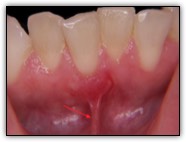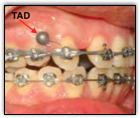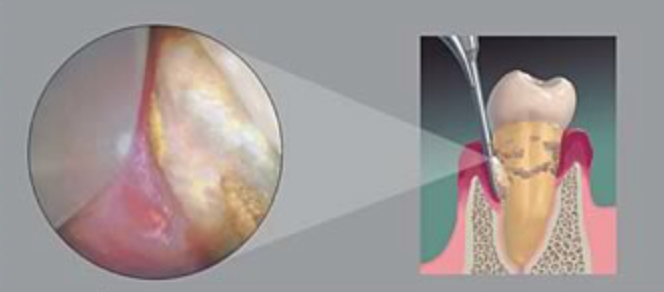Portfolio of Services
Examples of services we provide with information related to Periodontics and Dental Implants. The photographs are actual cases treated by Dr. Silvers and restored by the referring Dentist or Prosthodontist. It is important to note that successful outcomes result from careful planning by the dental "team". We work together to achieve for you the best result possible.
-
Connective Tissue (Gum) GraftsGum (Gingival) recession can often be corrected with connective tissue grafts. Indications include: progressive recession, gum inflammation, or lack of an adequate band of firm tissue around the neck of the tooth or dental implant.
The source of the graft can be one's own tissue or processed, processed commercially available tissue (allograft). It is important to determine the etiology or cause of the recession in order to prevent those factors from contributing to future loss of gum tissue. Overzealous toothbrushing is a common cause of recession for example. -
Dental ImplantsImplants replacing anterior teeth should appear and function like natural teeth. Managing the hard and soft tissues around implants is paramount to a successful outcome. A comprehensive evaluation of the adjacent teeth and gum tissue is necessary for anticipating any potential challenges so they can be successfully managed.
-
Crown LengtheningCrown lengthening is the process of exposing additional tooth structure for the purpose of improving the appearance of the teeth or to provide access to decay/fractured tooth area for repair. Often "short" or small teeth are not small at all but are still covered by an excess of gum tissue.
Uncovering the hidden tooth structure and recontouring the shape of the tissue can markedly improve the appearance of one's smile. -
Reconstuctions Involving Multiple ModalitiesMore involved situations may require several different treatment modalities to manage all of the teeth as a whole (the dentition). Periodontal plastic procedures, crown lengthening, ridge augmentation, and gum grafting, may be performed in conjunction with treatment of gum disease or dental implant placement for example.
-
Periodontal DiseaseThe root of the tooth is anchored in bone; the gum tissue covers the bone and the neck of the tooth. The edge of the gum where it meets the tooth is not attached; rather there is small space between the gum and tooth. We can insert a small probe like a “measuring stick” to determine the depth of this space. When you have periodontal disease, this supporting tissue and bone is destroyed, forming "pockets" around the teeth.

Over time, these pockets become deeper, providing a larger space for bacteria to live. As bacteria develop around the teeth, they can accumulate and advance under the gum tissue. These deep pockets collect even more bacteria, resulting in further bone and tissue loss. Eventually, if too much bone is lost, the teeth will need to be extracted.
The initial phase of treatment commonly involves scaling and root planning. The gum tissue is anesthetized so that careful cleaning of the root surface in the periodontal pocket can be accomplished. This cleaning removes the bacteria and “tartar” and provides a smooth surface to allow the gums to heal from the inflammation cause by the bacteria. The results of scaling and root planning are determined 4-6 weeks later.
Areas of the mouth, which have not responded to this non-surgical treatment, may require periodontal pocket reduction procedures. Here the gum is pushed away from the tooth to get direct access to the disease supporting tissues around the teeth, if appropriate bone grafts, or tissue stimulating proteins may be introduced to encourage regeneration of lost bone and tissue. The end result should be the elimination of the deep pockets and healthy, firm gum tissue. -
FrenectomyA frenectomy is the removal of a band of tissue that is attached inside the lip or cheek to the gums. The attachment to the gum tissue can be between the teeth and rather fibrous. Most commonly done in conjunction with orthodontic treatment when leaving this fibrous tissue can cause the teeth to move apart or lead to recession from “pulling” on the gum tissue adjacent to the tooth. A lingual frenum is a similar “web” of tissue that attaches the tongue to the floor of the mouth. It can be attached near the tip resulting in being “tongue tied," releasing this can allow more movement of the tongue which can have an improved effect on speech.

-
Mini Implants (TADS) to Assist Orthodontic TreatmentTemporary anchorage devices (TADS) are mini implant that are used to assist your orthodontist in more efficiently moving teeth into their final positions. After orthodontic treatment is completed they are easily removed.

-
Occlusal (Bite) Adjustments, Bite SplintsOur comprehensive examination includes an evaluation of your occlusion or how the teeth come together. Excessive forces on individual teeth or the entire dentition can influence the outcome of periodontal therapy and the longevity of dental implants for example.
Selectively adjusting the contact points on the teeth can eliminate these potentially damaging forces. Bruxism or clenching can be managed with the fabrication of a bite splint. This can help to eliminate excess wear on the teeth and symptoms related to the “jaw joint” (TMJ). An understanding how the teeth function during chewing allow us to more predictably manage many dental problems. For example, excessive forces on an individual tooth may result in a fracture or loosening over time. -
Peri-Implant DiseasesSimilar to a natural tooth, bacteria that is left to accumulate on the gum tissue around an implant can cause the gums to become inflamed (peri-implant mucositis). If left unchecked the inflammation can reach into the deeper tissue and result in bone loss around the implant (peri-implantitis). Just like natural teeth proper brushing, flossing and maintenance is the key to keeping your implant healthy.
Risks factors for developing peri-implant disease include previous periodontal disease diagnosis, poor plaque control, smoking, and diabetes. It is essential to routinely monitor dental implants as part of a comprehensive periodontal evaluation. Fortunately, we can often times “rescue” ailing implants through a variety of treatments based on the nature and extent of the problem. -
Minimally Invasive Periodontal TreatmentWe can utilize a periscope, a miniature camera and tiny probe that can be gently placed under the gum to diagnose and treat periodontal disease in a very minimally invasive way.





